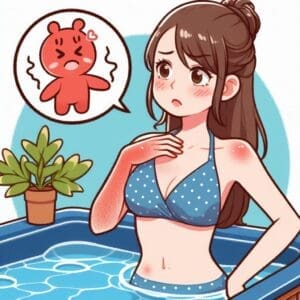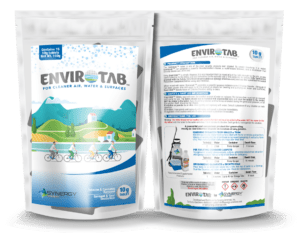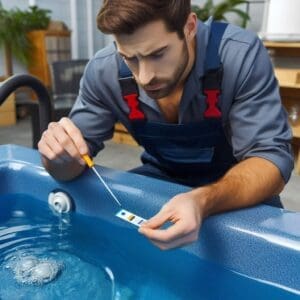The Hidden Risks of Poor Hot Tub Sanitation
Whether you're managing a vacation rental, wellness retreat, gym facility, or a shared-use spa, the time between guests is critical for resetting your hot tub to a safe and sanitary baseline.

Failing to sanitize properly between user groups can lead to serious health consequences, including:
- Pseudomonas dermatitis ("hot tub rash") – a painful skin infection caused by bacteria in poorly disinfected water.
- Folliculitis – inflamed hair follicles from contaminated water.
- Urinary tract infections (UTIs) – particularly common among female users.
- Eye, ear, and respiratory irritation – due to biofilm bacteria and poor chemical balance.
- Biofilm buildup – which harbors pathogens and drastically reduces sanitizer effectiveness.
These issues can lead to negative guest experiences, poor reviews, liability risks, and potentially, health code violations. Fortunately, chlorine dioxide (ClO₂) offers a safer, more reliable way to sanitize your hot tub between guests.
Why Choose Envirotab Chlorine Dioxide (ClO₂) for Turnover Sanitation
Traditional chlorine-based systems struggle under heavy use. Chlorine binds to organic material, forming chloramines — irritating byproducts that cause odors, red eyes, and reduced efficacy. In contrast:
- ClO₂ selectively oxidizes harmful substances without forming irritating residues.
- It penetrates biofilm and disinfects hard-to-reach plumbing lines.
- It leaves water odorless, clear, and safe for immediate reuse after proper testing.
Envirotab ClO₂ tablets make spa recovery simple, precise, and user-friendly — ideal for hospitality and shared-use environments.
Recommended ClO₂ Levels and Recovery Timeline
| Stage | ClO₂ Target | Purpose |
|---|---|---|
| Pre-use Check | 0.2–0.5 ppm | Confirm baseline sanitation before next group arrives |
| Post-use Recovery | Up to 1.0 ppm | Oxidize contaminants, sanitize spa between uses |
| Pre-use After Recovery | 0.2–0.5 ppm | Ensure residual levels are safe and effective |
Step-by-Step Guide: Recovering a Hot Tub Between User Groups
1. Test Water Immediately After Use
Use a ClO₂ test strip or digital photometer to get a snapshot of current conditions. Expect to see:
- ClO₂ below 0.2 ppm
- Slight cloudiness or organic odor
- Potential pH shift from user load
Record results in a logbook, especially if operating a commercial or rental unit.
2. Shock with Envirotab ClO₂ Tablets

Add a shock dose to rapidly oxidize contaminants introduced by the previous group.
Dosage:
- Add 1 Envirotab tablet per 100 gallons
- Example: For a 400-gallon hot tub, use 4 tablets
Place tablets in the skimmer or filter basket, not directly on surfaces.
3. Circulate for 30 Minutes
- Run the pump and jets to fully dissolve the tablets and distribute the ClO₂ throughout the system, including the plumbing lines and filters.
- Keep the cover partially open during this time to allow for off-gassing of oxidized organics.
4. Rinse or Replace Filters
- Remove the cartridge filter and rinse thoroughly with clean water. If it's heavily soiled, consider soaking it in a filter cleaner or replacing it entirely.
- This step is especially important in high-use or rental tubs where organics can build up quickly.
5. Balance pH (If needed)
- Test and adjust pH to fall within the 7.2–7.6 range. Though ClO₂ doesn’t significantly alter pH, guest use (especially with lotions, sweat, or cosmetics) can drive it out of range.
- Balanced pH ensures ClO₂ remains effective and minimizes skin/eye irritation.
6. Retest ClO₂ Before New Guests Arrive

Allow water to settle for 30–60 minutes post-shock and then retest ClO₂.
- If levels are above 0.5 ppm, let the tub aerate until it drops into the safe use range (0.2–0.5 ppm).
- If levels are too low (<0.2 ppm), add a partial tablet and circulate for 15 minutes.
Once ClO₂ stabilizes within target range, your hot tub is ready for the next group.
Additional Best Practices for Shared-Use Spas
- Guest Notification Signage: Let renters or guests know that water is professionally sanitized with ClO₂ — it builds trust and shows commitment to hygiene.
- Daily Logbooks: Required for commercial spas, useful for rentals. Track test results, dosing, and filter cleanings.
- Regular Deep Cleans: Schedule a deep clean (see Blog Post 3) every 2–4 weeks to prevent long-term buildup.
- Automate When Possible: Consider dosing timers or floating dispensers for consistent residual control.







